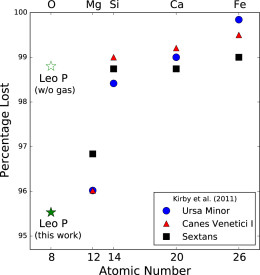Measurements of metal abundances in galaxies present a conundrum: compared to expectations, there are not nearly enough metals observed within galaxies. New observations of a nearby dwarf galaxy may help us understand where this enriched material went.
Removal Processes
Star formation is responsible for the build-up of metals (elements heavier than helium) in a galaxy. But when we use a galaxy’s star-formation history to estimate the amount of enriched material it should contain, our predictions are inconsistent with measured abundances: large galaxies contain only about 20–25% of the expected metals, and small dwarf galaxies contain as little as 1%!
So what happens to galaxies’ metals after they have been formed? The favored explanation is that metals are removed from galaxies via stellar feedback: stars that explode in violent supernovae can drive high-speed winds, expelling the enriched material from a galaxy. This process should be more efficient in low-mass galaxies due to their smaller gravitational wells, which would explain why low-mass galaxies have especially low metallicities.
But external processes may also contribute to the removal of metals, such as tidal stripping during interactions between galaxies. To determine the role of stellar feedback alone, an ideal test would be to observe an isolated low-mass, star-forming galaxy — i.e., one that is not affected by external processes.
Luckily, such an isolated, low-mass galaxy has recently been discovered just outside of the Local Group: Leo P, a gas-rich dwarf galaxy with a total stellar mass of 5.6 x 105 solar masses.
Isolated Results

Percentage of oxygen lost in Leo P compared to the percentage of metals lost in three other, similar-size dwarfs that are not isolated. If the gas-phase oxygen in Leo P were removed, Leo P’s measurements would be consistent with those of the other dwarfs. [McQuinn et al. 2015]
In non-isolated dwarf-spheroidal galaxies of similar mass to Leo P, 99% of their expected metals are missing. In comparison, the authors find that Leo P is missing 95% of its expected metals. From these results, it seems that expulsion of enriched material by stellar feedback alone can explain most of the missing metals in such galaxies; external factors only remove an additional few percent.
This explanation is further supported by the fact that, of the oxygen remaining in Leo P, 25% is locked up in stars, whereas 75% is found to be in gas form in the galaxy’s interstellar medium. If this 75% were stripped away by external processes, Leo P’s measurements would become consistent with those of the non-isolated dwarf galaxies.
Citation
Kristen B. W. McQuinn et al 2015 ApJ 815 L17. doi:10.1088/2041-8205/815/2/L17
